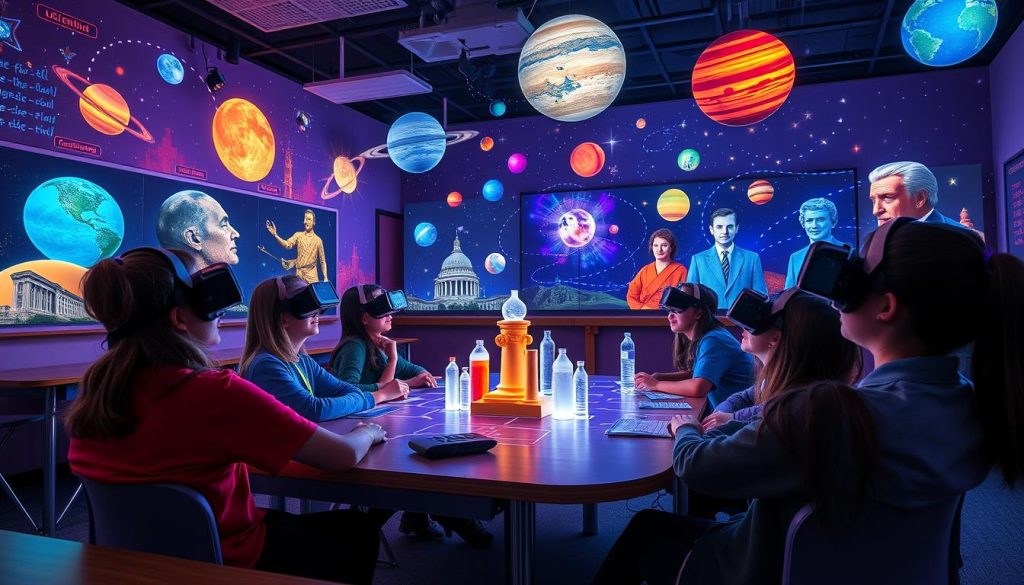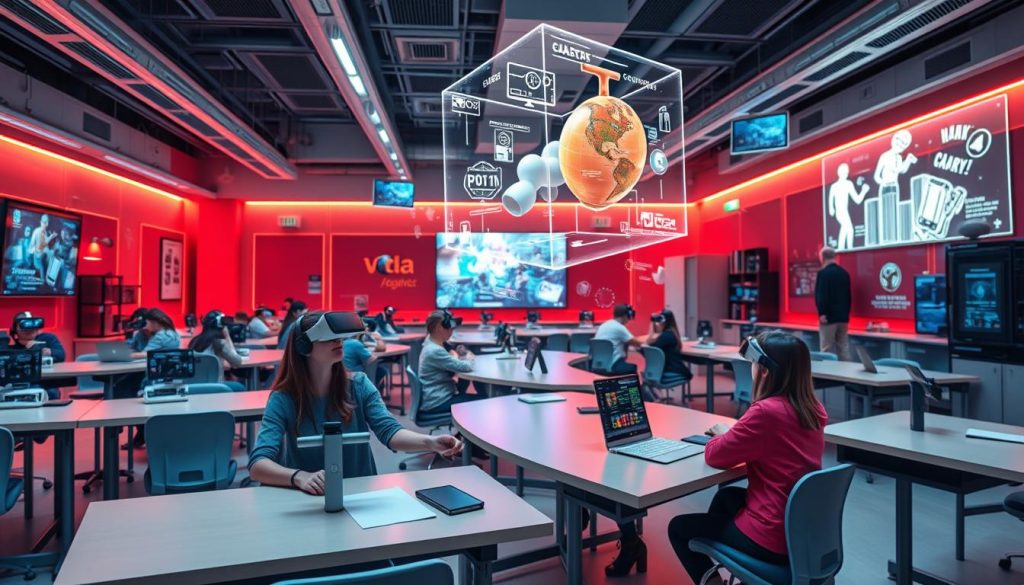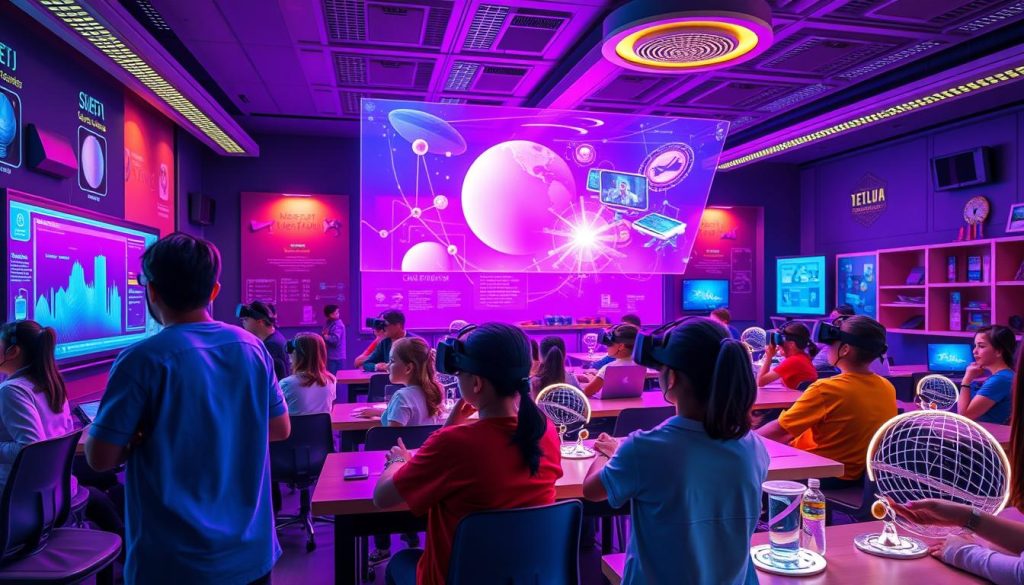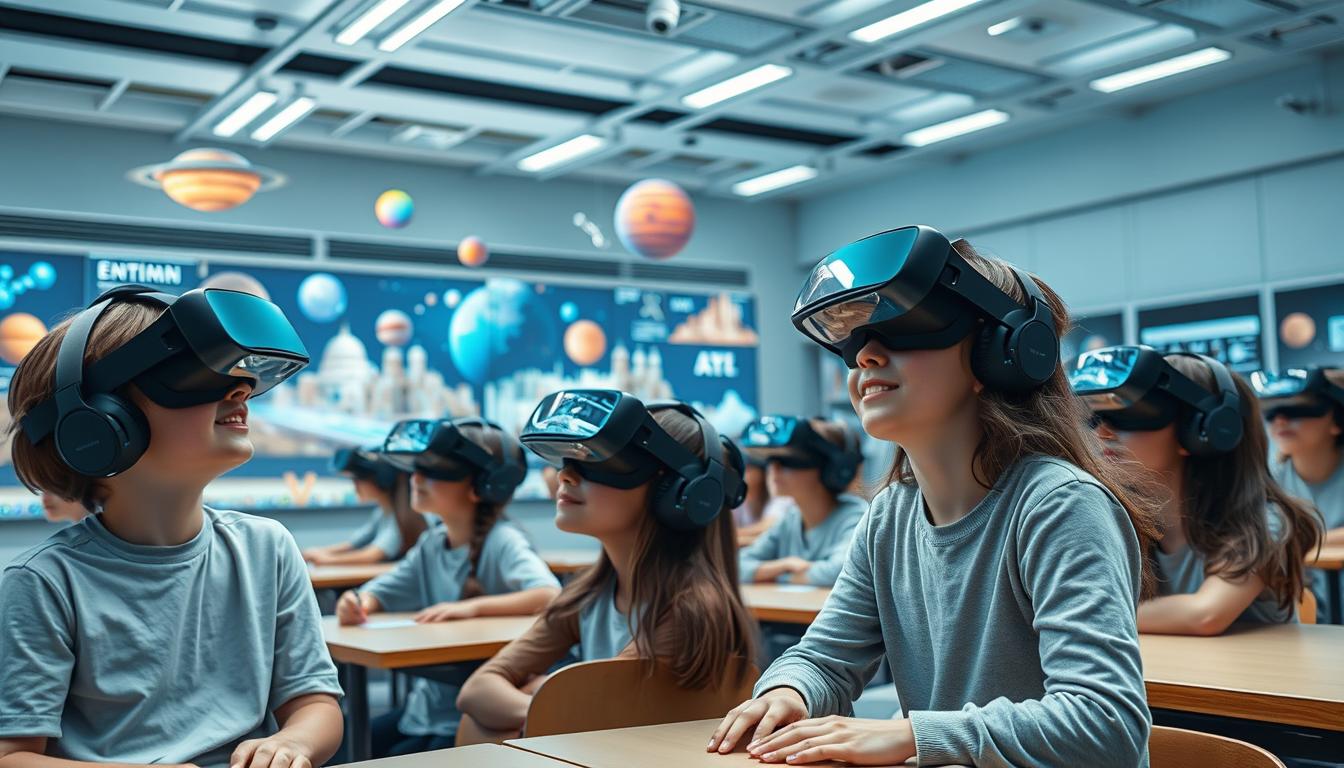In recent years, education has seen a big change with virtual reality learning tools. These tools make learning more fun and interactive. They help students understand and remember what they learn better.
Let’s dive into the advantages of these tools. We’ll see how virtual reality is changing the way we teach. It’s making learning more engaging and effective.
What Are Virtual Reality Learning Tools?
Virtual reality learning tools change how we learn by using interactive and immersive simulations. They let students dive into content in ways old methods can’t. By stepping into VR worlds, learners get a hands-on feel that boosts understanding and memory.
Defining Virtual Reality in Education
Virtual reality in education uses tech to make learning environments feel real and immersive. It’s different from usual teaching methods because VR lets students see and do things in 3D. They can touch virtual objects, visit historical places, or do experiments, making hard ideas easy to grasp.
Key Components of VR Learning Tools
The power of virtual reality learning tools comes from a few key parts:
- VR Headsets: These devices give students a full visual dive into virtual worlds, keeping them fully engaged.
- Interactive Simulations: These let learners play with and change things in the virtual space, making learning fun and active.
- Spatial Audio: This tech adds to the real feel by changing sounds based on where and how the user moves.
These parts work together to make a space where students can really grow. Here’s a look at how VR learning compares to old-school methods:
| Attribute | Traditional Learning | VR Learning Tools |
|---|---|---|
| Engagement Level | Passive | Active |
| Learning Experience | Textbook-Based | Immersive Simulations |
| Retention Rates | Moderate | High |
| Collaboration | Limited | Enhanced |
Benefits of Immersive Educational Technologies

Immersive educational technologies are changing how students learn. They make learning fun and engaging. This boosts student motivation a lot. Teachers see a big change when they use these tools in class.
Enhancing Engagement and Motivation
Virtual reality and similar tech make learning interactive. Students get more excited about learning. They feel like they’re part of the action.
This makes them connect with the material on a deeper level. It’s not just about reading or listening. It’s about doing and experiencing.
Promoting Retention and Understanding
These technologies also help students remember what they learn. Studies show they remember more than in regular classes. This is because they get to apply what they learn in real ways.
By diving into learning, students grasp concepts better. They make connections that help them understand more.
| Type of Learning Experience | Engagement Level | Retention Improvement |
|---|---|---|
| Traditional Classroom | Moderate | 30% |
| Virtual Reality Experience | High | 70% |
| Interactive Simulations | Very High | 80% |
Using these technologies creates a lively learning space. It also gets students ready for future challenges.
Virtual Reality Learning Tools in the Classroom

Adding virtual reality tools to classrooms brings new ways to learn. These tools change how we teach, making learning more fun. Schools across the country are using VR to improve education, showing great results.
Real-World Applications and Case Studies
Many schools use virtual reality to make learning more engaging. Here are some examples:
| Institution | Application | Results |
|---|---|---|
| Mount Auburn Elementary | VR field trips to historical sites | Increased student interest by 50%, enhanced understanding of history. |
| Riverside High School | Virtual science labs | Improved lab skills and safety awareness, reduced material costs by 30%. |
| Cedar Valley College | Medical training simulations | Higher pass rates in practical exams, better preparedness for real-world scenarios. |
Integrating VR into Existing Curriculum
Integrating VR into curriculum requires careful planning. Here are some tips:
- Find topics like biology and history that fit well with VR.
- Work with teachers to create VR modules that meet learning goals.
- Use VR to support project-based learning and assessments.
- Provide training for teachers to help them feel comfortable with VR.
Exploring Interactive Learning Experiences

Interactive learning experiences are changing education, especially with virtual reality. VR lets students learn by doing, not just watching. This hands-on approach helps them understand complex topics better.
Creating Hands-On Learning Opportunities
Virtual reality changes how we learn. Students can play with 3D models, making abstract ideas real. For example:
- Science Labs: Students can do virtual experiments safely.
- History Exploration: VR lets them explore historical sites and events.
- Engineering Challenges: They can design and test structures in a simulated world.
Facilitating Collaborative Learning Environments
Virtual reality makes teamwork easier. Students work together in a shared space. This helps them learn to communicate and work together better. VR helps in many ways, like:
- Group Projects: Students can work on projects together, no matter where they are.
- Real-Time Problem Solving: They must share ideas to solve challenges.
- Peer Review Sessions: Students can give feedback right away, improving learning.
Interactive learning shows the power of hands-on and team-based learning. Schools can improve student engagement and skills by using these methods.
| Learning Approach | Traditional Learning | Virtual Reality Learning |
|---|---|---|
| Engagement Level | Low | High |
| Collaboration | Limited | Extensive |
| Hands-On Opportunities | Minimal | Abundant |
| Flexibility | Static | Dynamic |
Future Trends in Augmented Reality Education
Looking ahead, augmented reality education is set to change how we learn. This technology will bring more interactive and immersive experiences. It will work alongside virtual reality to make learning more engaging and effective.
Another exciting trend is the drop in AR device prices. As prices fall, more classrooms will use AR. This will help teachers use new ways to teach, reaching all kinds of learners.
Teachers will soon have tools to make AR experiences fit their lessons. This means students will get to learn in ways that interest them. The mix of AR and VR will change education, making it more fun and effective.

